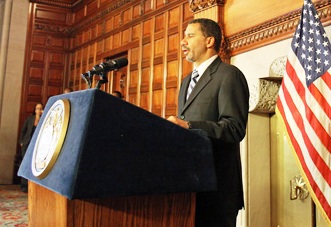FOR IMMEDIATE RELEASE:
July 10, 2009
GOVERNOR PATERSON RELEASES REPORT DETAILING SIGNIFICANT REFORMS TO NEW YORK'S PUBLIC HEALTH INSURANCE PROGRAMS
Successful Efforts to Transform Medicaid into a High Quality, Cost-Effective Health Insurer Position State for National Reform
 Governor David A. Paterson today announced the release of New York State's 2007-2009 Health Care Transformation Report which outlines the progress the State has made over the past two years to reform New York Medicaid into a high-quality, cost-effective health insurance program.
Governor David A. Paterson today announced the release of New York State's 2007-2009 Health Care Transformation Report which outlines the progress the State has made over the past two years to reform New York Medicaid into a high-quality, cost-effective health insurance program.
"There are 45 million uninsured Americans, two and half million of whom live in New York," said Governor Paterson. "Restructuring the Medicaid program so that it can provide a strong foundation for coverage expansion and more sweeping national reform is a federal and state challenge. In New York, we have risen to that challenge. This report documents the progress we have made in transforming New York Medicaid into a high-quality, cost-effective health insurance program, capable of playing a leading role in national reform that President Obama has called 'a fiscal and moral imperative.'"
The report, Transforming New York's Public Health Insurance Programs: Expanding Access, Improving Quality and Controlling Costs, cites how New York's Medicaid program has been reformed through the reduction of inpatient rates, investment in primary and preventive care and ambulatory care services, and by providing incentives to practitioners who work in medically underserved areas and meet patient-centered medical home standards that advance integrated and coordinated care.
In addition to reforming reimbursement systems, New York has implemented several major initiatives to strengthen the quality of care delivered to enrollees, thereby improving enrollee outcomes and overall health. These initiatives include:
- selective contracting for certain procedures to ensure that beneficiaries receive care in facilities that produce the best outcomes;
- non-payment for 'never events', avoidable hospital complications and medical errors that are identifiable, preventable and serious in their consequences to patients;
- the introduction of comprehensive service utilization review to help Medicaid better identify patterns of inappropriate health care utilization for the benefit of beneficiaries and overall program efficiency; and
- a number of pharmacy initiatives intended to reduce medication errors, as well as encourage pharmaceutical practices that produce better patient outcomes and yield savings.
New York State Health Commissioner Richard F. Daines, M.D. said: "Medicaid is the single largest purchaser of health care in New York State, insuring more than 4 million New Yorkers and costing almost $50 billion. We can utilize Medicaid's purchasing power to move our health care system toward more efficient and effective delivery models. Through Governor Paterson's leadership, New York's Medicaid program is uniquely positioned to expand coverage, improve quality and control costs, which is in alignment with the health care reform agenda that President Obama has put forth at the national level."
The 2007-2009 Health Care Transformation Report also highlights New York's efforts to tackle the complex and misaligned eligibility rules embedded in its public insurance programs, eliminating some and streamlining others, so that eligible New Yorkers are able to obtain and maintain health insurance coverage.
To ensure that all New York children have access to health care, the State expanded its Child Health Plus program so that children in families with incomes between 250 and 400 percent of the Federal Poverty Level are eligible for coverage. Additionally, recognizing that health insurance coverage does not guarantee access to care, in 2008 New York established the Doctors Across New York Program. This program provides financial support to practices in medically underserved rural and urban communities, so that all New Yorkers can have access to a doctor within a reasonable distance of their homes.
New York State Medicaid Director and Deputy Commissioner for the Office of Health Insurance Programs at the New York State Department of Health, Deborah Bachrach said: "Governor Paterson has taken bold steps to make certain that low-income New Yorkers are able to get and keep the health insurance coverage they need. Payment and program reforms ensure that Medicaid buys real value for patients and taxpayers alike, while making coverage expansions possible."
To view the full report, please visit http://www.nyhealth.gov/health_care/docs/2007-2009_health_care_transformation_report.pdf .
More information about New York State's Medicaid program can be found at http://www.nyhealth.gov/health_care/medicaid/ .
